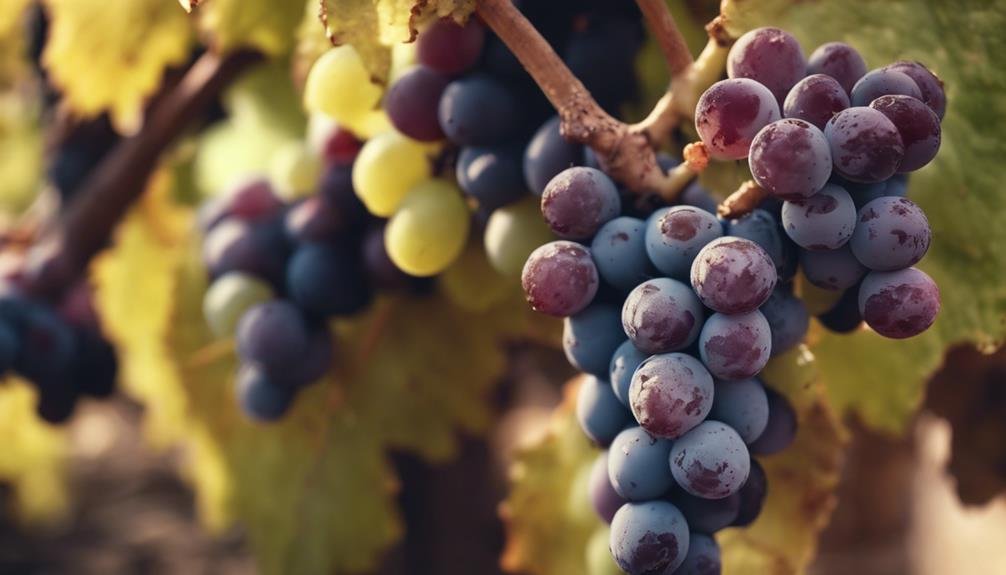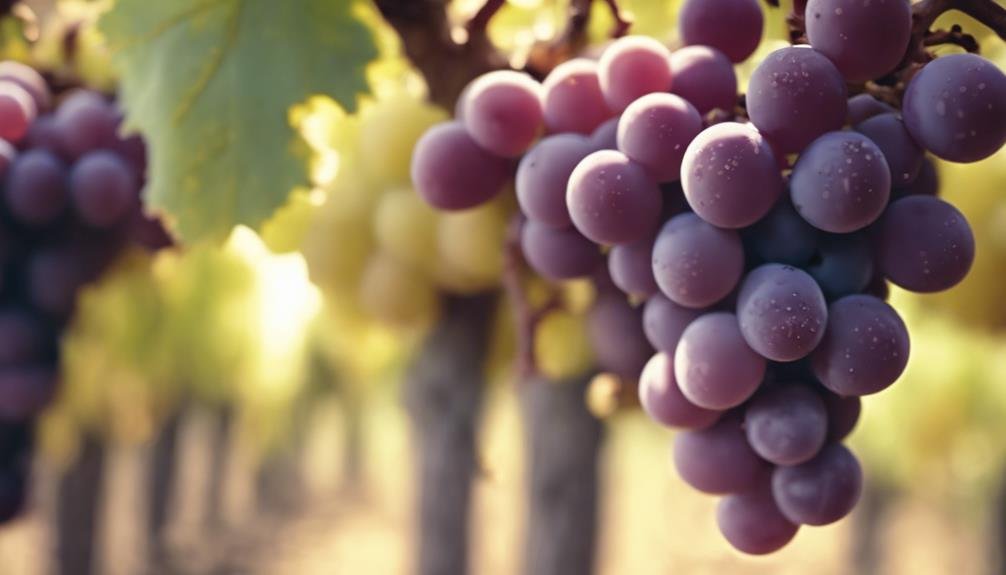Noble Rot, also known as Botrytis cinerea, plays a unique role in winemaking by enhancing sweetness and flavor complexity. This naturally occurring fungus affects grapes, leading to a concentration of sugars and the development of rich profiles with hints of dried fruit, caramel, and honey notes. Wines like Sauternes and Tokaji Aszu are celebrated for their luscious sweetness attributed to Noble Rot. By understanding how this phenomenon influences dessert wines, enthusiasts can appreciate the distinct taste and aroma experiences offered. Further exploration into Noble Rot's impact uncovers a fascinating world of wine craftsmanship and flavor evolution.
The Origin and Impact of Noble Rot
The cultivation of Noble Rot, also known as Botrytis cinerea, has greatly influenced the sweetness and flavor profiles of select wine varieties, enhancing their complexity and desirability in the world of winemaking.
This fungus thrives in riverbank vineyards, where it causes a unique type of fungal fermentation on grapes. Wines like Sauternes and Tokaji Aszu owe their luscious sweetness and rich flavors to this phenomenon.
The Botrytis affected wines, often associated with river proximity, exhibit characteristics like dried fruit, caramel, and honey. Some exceptional wines, such as Verglas, combine the techniques of ice wine with the influence of Botrytis, resulting in a truly distinctive and sought-after wine profile.
Noble Rots Influence on Wine Sweetness
An essential factor influencing the sweetness of wines is the presence of Noble Rot, a beneficial fungus known for intensifying sugar levels and adding complexity to the flavor profile.
When Noble Rot affects wine grapes, it initiates a dehydration process that concentrates the sugars within the grape, leading to a higher level of sweetness in the final product.
This natural dehydration results in dessert wines that are not only sweeter but also exhibit a unique sweet complexity characterized by flavors like honey, beeswax, and ginger.
The dehydration process induced by Noble Rot guarantees that the grapes maintain their sugar levels, contributing to the luscious and viscous texture often found in wines affected by this fungus.
Historical Mold Challenges in Winemaking

Noble Rot's impact on wine sweetness highlights just one aspect of the challenges winemakers have historically faced due to mold infestations.
- Varied Types of Mold: Winemakers have encountered molds like Powdery Mildew, Cork Taint, and Black Mold, each presenting unique challenges to wine production.
- Impact on Wine Quality: Mold management is essential for maintaining the quality of wines, as mold infestations can lead to spoilage and off-flavors in the final product.
- Historical Significance: Mold issues have been a persistent challenge for winemakers throughout history, driving the development of techniques and practices to combat their detrimental effects on wine production.
Exploring the Profile of Noble Rot Wine
Exploring the distinctive characteristics of wines influenced by the Botrytis cinerea fungus reveals a complex interplay of flavors and aromas that elevate these dessert wines to a unique status in the world of winemaking.
Wines affected by 'Noble Rot' exhibit flavor complexity with notes of dried fruits, caramel, and honeyed nuances. The aroma compounds in these wines, such as phenylacetaldehyde, contribute to their rich and intense sensory profile.
Some wines, like Verglas, combine the ice wine technique with botrytis-affected grapes, resulting in a unique wine profile that marries the sweetness of dessert wines with the crisp acidity of ice wines. This combination creates a distinctive taste experience that sets 'Noble Rot' wines apart in the domain of winemaking.
Key Insights and Sources on Noble Rot

Within the domain of winemaking, understanding the significance of 'Noble Rot' involves delving into its key insights and reputable sources.
- Botrytis Characteristics in Winemaking: Botrytis cinerea, the fungus responsible for Noble Rot, dehydrates grapes, concentrating sugars and intensifying sweetness in dessert wines.
- Phenylacetaldehyde Levels and Aroma Compounds: Noble Rot wines often exhibit higher levels of phenylacetaldehyde, contributing to their unique aroma profile with notes of honey, beeswax, and ginger.
- Reputable Sources: Academic research on Red Botrytis wines, the fungal group Ascomycota to which Botrytis cinerea belongs, and insights from experienced winemakers like Tim Martiniuk from Stoneboat Vineyards provide valuable information on Noble Rot and its impact on winemaking.
Frequently Asked Questions
How Does Noble Rot Affect the Texture of Wine?
Noble Rot enhances wine texture by intensifying sweetness levels while maintaining grape integrity. This process results in a unique aroma profile with flavors like honey, beeswax, and ginger. The impact of Noble Rot on wine texture is distinctive and sought after by connoisseurs.
Can Noble Rot Occur Naturally in All Vineyards?
Noble Rot, caused by Botrytis cinerea, occurs naturally in vineyards with specific conditions like high humidity. Not all vineyards experience this phenomenon. Factors like proximity to rivers and morning fog play a role in the natural occurrence of Noble Rot.
Which Other Fruits Besides Grapes Can Be Affected by Noble Rot?
Noble Rot, as Botrytis cinerea, affects various fruits besides grapes, such as strawberries, cherries, and kiwis. While mainly recognized in winemaking, this fungus can also enhance flavors in culinary dishes, like jams and desserts.
Are There Any Health Risks Associated With Consuming Noble Rot Wines?
Health risks associated with consuming Noble Rot wines are minimal. The fermentation process mitigates harmful elements. However, those with mold allergies should be cautious. The benefits of these wines, like flavor complexity and potential antioxidant properties, generally outweigh any potential risks.
Can Noble Rot Be Intentionally Induced in Grape Cultivation?
Inducing noble rot in grape cultivation is possible through intentional methods. This process enhances grape quality by intensifying sweetness, affecting fermentation, and influencing flavor profiles. Winemakers employ specific techniques to encourage this beneficial fungus for distinct wine characteristics.
Conclusion
To sum up, the enigmatic allure of noble rot in winemaking continues to captivate and mystify enthusiasts worldwide.
This sweet secret of the wine world, with its ability to elevate flavors and sweetness levels, adds a touch of magic to the craft of producing exceptional wines.
Despite its challenges and historical significance, noble rot remains a cherished and integral part of creating some of the most coveted and exquisite wines known to connoisseurs.
